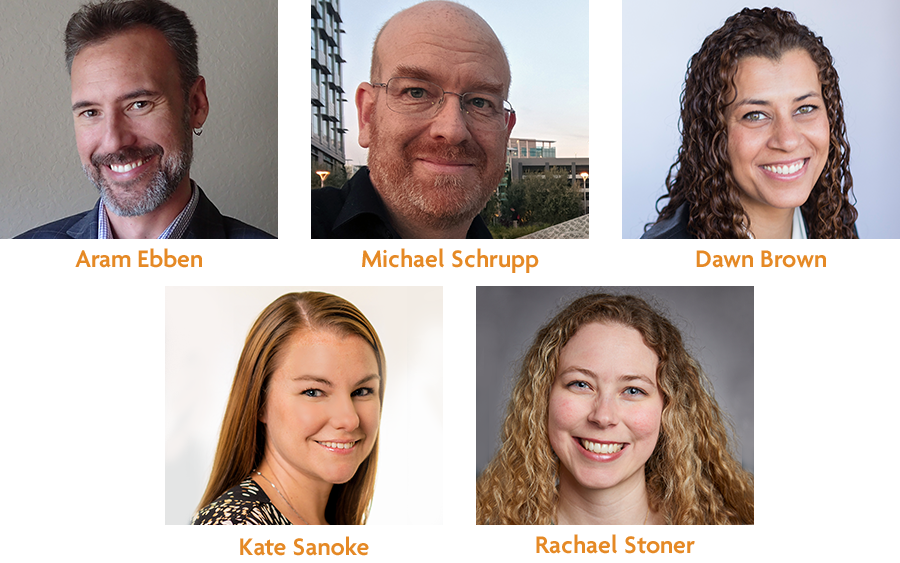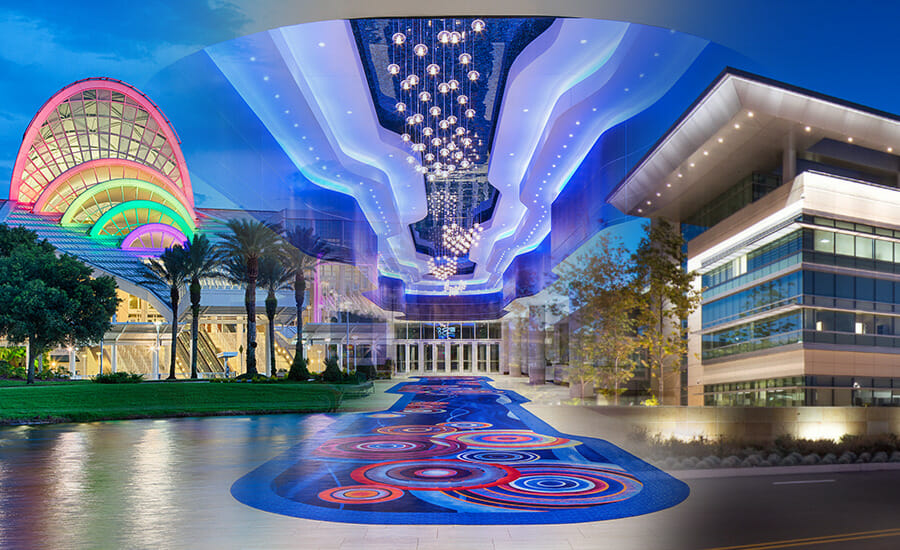At EXP, each project’s success is due to a combination of well-conceived forces. Our lighting designers are experts in the power of light and enhancing spaces for clients by fusing innovative technology and creativity. “A good lighting design highlights the work that the entire production team has labored to create. Lighting is critical to how the built environment is perceived and how users of a space function and feel,” said Lighting Director, Michael Schrupp.
To learn more about EXP’s lighting design team, their role in the design process and what inspires their creativity, we spoke with EXP’s Principal, Director of Lighting Design, Aram Ebben and members of his team including Michael Schrupp, Rachael Stoner, Dawn Brown and Kate Sanoke.

What inspired you to become a lighting designer?
Rachael Stoner: My mom worked in graphic design, and my dad started as a carpenter and moved into general contracting. I’ve always thought of myself as a blend of those two with the addition of light.
Aram Ebben: It was a culmination of early education in art, a love of the spectacle of theatre and the realization of the power of light to transform a space and create memories.
Dawn Brown: The opportunity to be involved in both the creative and technical aspects of architectural design and construction.
Michael Schrupp: I was studying film production in college when I enrolled in the Theatrical Stage Lighting class. After one semester and lighting a graduate showcase performance, I was hooked! Lighting brought me back to the theatre community I grew up with and I loved the mix of art and science and finding a new way to tell stories through beautifully crafted atmospheres.
Kate Sanoke: Lighting design for me personally is the perfect mix of technical and creative. We are pushed to tell a story; to make people feel something; to provide innovative and wildly creative solutions all within the confines of an environment with real technical parameters and design criteria.
How do you communicate a client’s vision through lighting design?
Aram: First, I listen carefully to all the stakeholders to understand their goals for the space. Our clients are the owners, operators, designers, engineers, contractors and finally, the guests who will ultimately experience that space. Each has a different vision of what story the space should tell. It’s important that they each get a voice in the design. Second, I study the various visions through the use of light and shadow, I work to express each of those visions and tell those stories in light. Lastly, I execute that design using whatever “tools” the story requires. With light, these are color, intensity, contrast, shadow and even dynamic motion where appropriate.
Dawn: Listen. Learn. Do. As Aram indicated, it’s critical to meet with the client and understand their objectives and the elements of the architecture that they wish to emphasize. Then comes research to understand regulatory requirements, end-user needs, historic significance, materials, geometry and dimensions. After that it’s just a matter of utilizing the right techniques, light sources and products to achieve the desired outcome.
When do you enter the design process?
Michael: We love being in the game from the get-go. We love those opportunities when we can be in early concept discussions and work through the ideas with the design team.
Rachael: Ideally, as soon as possible. That said, we do have the skillset to jump into a project during any phase of design. Sometimes we will be contracted for concept design only. We will do a beautiful concept book that has many renderings, inspiration images, glow plans and schematic diagram details—and that’s it! Alternatively, we can be looped in during the construction documentation phase and put pen to paper immediately and still provide a good design that satisfies the client.
What types of clients do you regularly work with?
Aram: The team’s clients are owners, operators, designers, engineers, contractors and guests. We work primarily with owners/developers, architects, landscape architects, interior designers, other engineering companies and general/electrical contractors. Within that group, they can vary from straight-forward corporate designers to creators of themed environments.
Do you have an area of expertise in terms of technique, project type technique or research investigations?
Dawn: I am very interested in circadian lighting Design. Circadian lighting is a method of design that utilizes our biological response to light to help achieve better sleep quality. We spend most of our time indoors, which causes our bodies to think we’re in a constant twilight, resulting in negative impacts on sleep. By using special LED lights and a well-thought-out controls strategy, we’re able to provide people with brighter days and darker nights to help keep their biological day/night cycle in sync with their social schedule. Right now, we’re focusing on long-term care, but circadian lighting can also be applied to a variety of other projects and is a feature of the WELL Buildings program.
Rachael: My experience is mainly in the hospitality market. Each year we get new and exciting projects which have allowed me to strengthen techniques in the transit and entertainment markets. Presently, I am working on mostly casino and hotel projects. Casinos are unique because they are open 24 hours a day, seven days a week and 365 days a year. There is contributing light from the slot machines and signage that we must consider. There is often a center feature bar that wants to be lit in a flashy and/or attractive way that is visible from the moment you enter the room 100ft away.
Kate: From being located in the Orlando office, I have been lucky to be exposed to a wide breadth of project types. One in specific that I have had extensive exposure to over the years is working in the hospitality market sector. This includes local projects, as well as projects in the Bahamas and many internationally. I also have become an expert on lighting for penguin exhibits! Penguins are very sensitive to their environments and require highly designed habitats to emulate daylight throughout the times of year to keep their biological clock properly in sync.
How does lighting impact a project’s success?
Aram: For sighted people, light and shadow are critical to the project’s success since it’s the primary way we experience a space. In theatre, we used to joke that without lights it’s radio. Lighting has the power to define a space, tell a story, elicit emotion and perhaps most importantly, create memories.
Michael: Good lighting will induce better wellness and productivity out of employees, can create eternal moments for a child on a ride, help boost sales of merchandise and may evoke an emotional response to the environment without a guest even understanding why.
Learn more about EXP’s lighting design team by contacting our experts:

